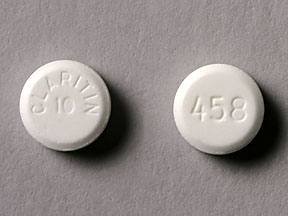Claritin Disease Interactions
There is 1 disease interaction with Claritin (loratadine).
Loratadine (applies to Claritin) renal/liver disease
Moderate Potential Hazard, High plausibility. Applicable conditions: Renal Dysfunction
Loratadine is primarily converted by the liver to an active metabolite, and both parent drug and metabolite are excreted in the urine. Patients with renal and/or liver disease may be at greater risk for adverse effects from loratadine due to drug and metabolite accumulation. The manufacturer recommends one-half the regular dosage initially in patients with liver failure or decreased renal function (GFR < 30 mL/min). Due to the differential effects of hepatic impairment on the serum half-life and clearance of loratadine and pseudoephedrine, the use of products containing a fixed combination of these drugs is not recommended in the presence of liver failure.
References (6)
- Matzke GR, Halstenson CE, Opsahl JA, Hilbert J, Perentesis G, Radwanski E, Zampaglione N (1990) "Pharmacokinetics of loratadine in patients with renal insufficiency." J Clin Pharmacol, 30, p. 364-71
- Clissold SP, Sorkin EM, Goa KL (1989) "Loratadine. A preliminary review of its pharmacodynamic properties and therapeutic efficacy." Drugs, 37, p. 42-57
- Hilbert J, Moritzen V, Parks A, Radwanski E, Perentesis G, Symchowicz S, Zampaglione N (1988) "The pharmacokinetics of loratadine in normal geriatric volunteers." J Int Med Res, 16, p. 50-60
- (2002) "Product Information. Claritin (loratadine)." Schering Corporation
- Schiano TD, Bellary SV, Cassidy MJ, Thomas RM, Black M (1996) "Subfulminant liver failure and severe hepatotoxicity caused by loratadine use." Ann Intern Med, 125, p. 738-40
- Monroe EW (1996) "Safety and efficacy of loratadine in urticaria." Int J Dermatol, 35, p. 837-41
Switch to consumer interaction data
Claritin drug interactions
There are 113 drug interactions with Claritin (loratadine).
Claritin alcohol/food interactions
There is 1 alcohol/food interaction with Claritin (loratadine).
More about Claritin (loratadine)
- Claritin consumer information
- Check interactions
- Compare alternatives
- Pricing & coupons
- Reviews (50)
- Drug images
- Side effects
- Dosage information
- During pregnancy
- Support group
- Drug class: antihistamines
- Breastfeeding
- En español
Related treatment guides
Drug Interaction Classification
| Highly clinically significant. Avoid combinations; the risk of the interaction outweighs the benefit. | |
| Moderately clinically significant. Usually avoid combinations; use it only under special circumstances. | |
| Minimally clinically significant. Minimize risk; assess risk and consider an alternative drug, take steps to circumvent the interaction risk and/or institute a monitoring plan. | |
| No interaction information available. |
See also:
Further information
Always consult your healthcare provider to ensure the information displayed on this page applies to your personal circumstances.


